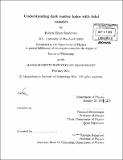Understanding dark matter halos with tidal caustics
Author(s)
Sanderson, Robyn Ellyn
DownloadFull printable version (18.51Mb)
Other Contributors
Massachusetts Institute of Technology. Dept. of Physics.
Advisor
Edmund Bertschinger.
Terms of use
Metadata
Show full item recordAbstract
The products of interactions between galaxies with a high mass ratio and low orbital angular momentum are studied. The interactions scatter the material from the smaller galaxy into structures with distinctive dynamics and morphology, including high local densities and a simple density profile related to properties of the participating galaxies. The role of the larger galaxy's tides in creating these structures and their relation to a well-studied class of mathematical objects motivates us to name them "tidal caustics". We study the densities achievable in tidal caustics for a typical merger of this type using an example from the Andromeda galaxy to determine whether they are sufficient to produce a detectable gamma-ray signal from self-interactions in the dark matter component, for likely particle models of dark matter. We find that the expected signal is an order of magnitude too low to be detected with current instruments. We also study the constraints that can be placed on the properties of the participating galaxies by observing the surface brightness profiles of the tidal caustics. We find that the local gravity and gravity gradient of the larger galaxy, and the energy spread and initial phase space density of the smaller galaxy, can be jointly constrained by fitting this profile. The constraints are degenerate but model-independent. We find that measurements of multiple caustics and the velocity of the material in each caustic along the line of sight give information about the orbital angular momentum and the deviations from spherical symmetry in the larger galaxy, though this information is somewhat model-dependent. We discuss the main technical difficulty in fitting the surface brightness profile: determining the inclination angle of the caustic. We demonstrate that a simple model can successfully recover the necessary parameters for some cases, and that a simple modification to this model will improve its success rate.
Description
Thesis (Ph. D.)--Massachusetts Institute of Technology, Dept. of Physics, 2011. Cataloged from PDF version of thesis. Includes bibliographical references (p. 181-188).
Date issued
2011Department
Massachusetts Institute of Technology. Department of PhysicsPublisher
Massachusetts Institute of Technology
Keywords
Physics.